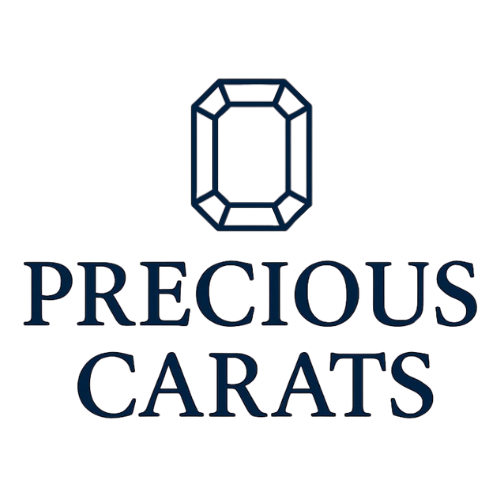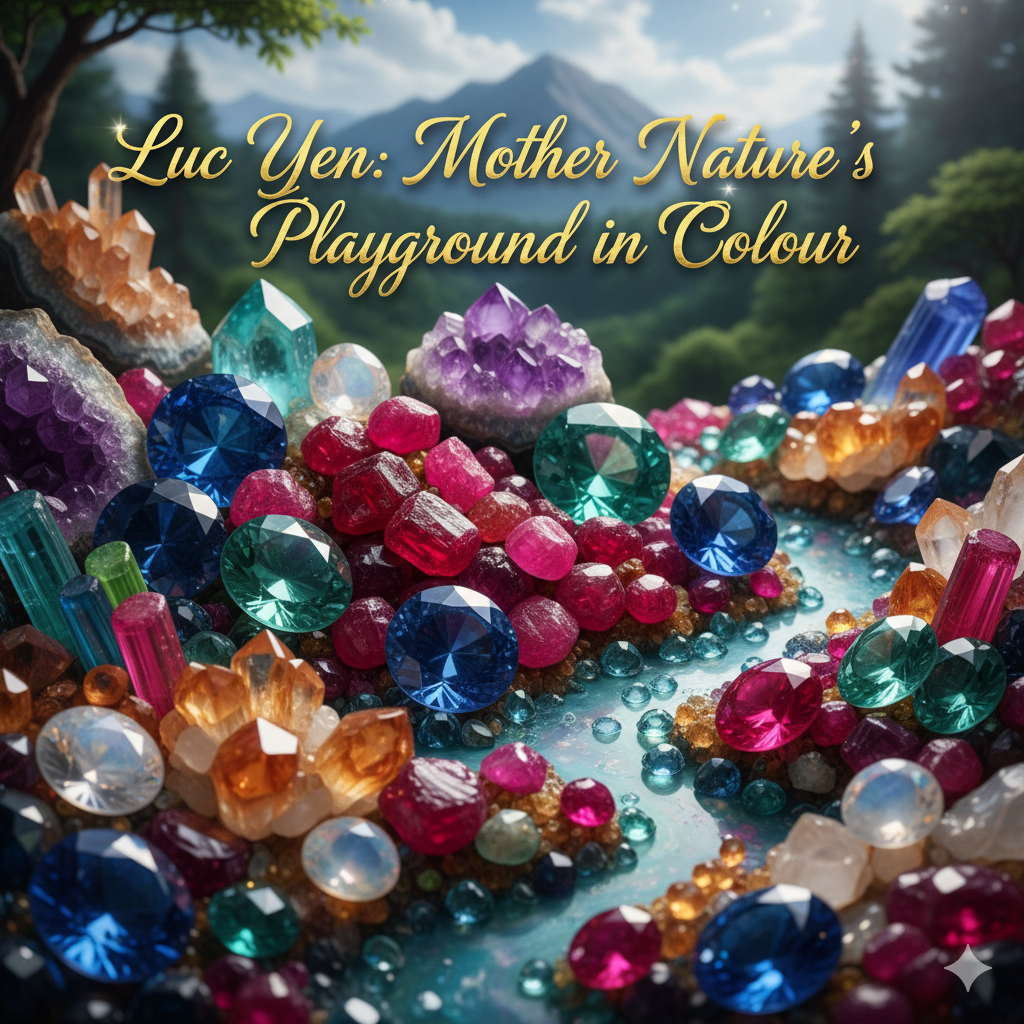Luc Yen: Mother Nature’s Playground in Colour
Where marble sleeps beneath green hills, and the earth dreams in blue, pink, and violet.
1. The Valley That Glows
Nestled in the mist-wrapped hills of northern Vietnam’s Yên Bái Province, the Luc Yen District is not a mining region — it is a palette.
From sunrise to dusk, colour seems to breathe from its soil: pink spinel in river gravel, blue spinel in marble cliffs, red ruby peeking through limestone, and green peridot glinting in sunlight.
To gem lovers, Luc Yen is no longer just a name.
It is a living studio where Mother Nature paints in fluorescence — a rare geological theatre where the entire spectrum exists in harmony.
2. Geography of Wonder
Luc Yen lies roughly 250 km northwest of Hanoi, bordered by mountains that rise to over 1000 m above sea level.
The district’s terrain combines marble, mica schist, and amphibolite — an ideal blend for gemstone formation through metamorphism.
Key formations:
- White marble host – home to spinel, ruby, and sapphire.
- Pegmatite intrusions – bearing tourmaline, topaz, and quartz.
- Alluvial gravels – rich in zircon, garnet, and peridot.
The region’s rivers — Thác Bà, An Phú, and Minh Tiến — wash tiny treasures downstream, replenishing gravel beds after each monsoon.
Every new season brings the possibility of discovery.
3. A History Written in Colour
Gem mining in Luc Yen began only in the late 1980s, after locals stumbled upon bright pink pebbles in paddy fields near Minh Tiến.
When analyzed in Hanoi, the stones proved to be spinel — and not just any spinel, but cobalt-bearing material with unreal neon fluorescence.
By the mid-1990s, rubies, sapphires, and garnets were also found in neighboring marble belts.
Thus began Vietnam’s quiet rise as a gem power — one that would rival Mogok, Sri Lanka, and Mahenge in the decades ahead.
4. The Colour Atlas of Luc Yen
| Gem Type | Signature Hue | Notable Feature |
|---|---|---|
| Spinel (Cobalt, Pink, Violet) | Electric blue to magenta | Strong fluorescence, unheated |
| Ruby & Sapphire | Pigeon-blood red, pinkish red, blue | Marble-hosted, low iron |
| Peridot | Golden-green | Clean, high transparency |
| Garnet (Malaia, Rhodolite) | Orange-rose to purple-red | Fine dispersion |
| Tourmaline & Zircon | Watermelon & honey hues | Common in pegmatite zones |
The soil here reads like a rainbow’s memory — a full chromatic circle compressed into one district.
5. The Spinel Renaissance
Luc Yen’s greatest contribution to modern gemology is the Cobalt Blue Spinel.
Discovered in the early 1990s, these gems stunned Bangkok and Geneva dealers with colour so electric it seemed artificial.
Later testing proved otherwise: cobalt had naturally replaced magnesium, creating the purest blue in spinel history.
Soon, Luc Yen’s pink and lavender spinels joined the legend — rivaling Burma’s Jedi and Tanzania’s Mahenge stones in glow.
Vietnam had become the new capital of fluorescence.
6. Ruby and Sapphire — The Marble Twins
Luc Yen’s rubies and sapphires form within the same marble belts as its spinel, giving them a shared ethereal transparency.
The rubies lean pinkish red, with soft internal light and minimal iron; the sapphires show delicate cornflower hues, often untreated.
While Burma’s stones speak of fire, Luc Yen’s whisper of serenity — colour as breath, not blaze.
7. Mining and People
Mining in Luc Yen remains artisanal. Families work shallow pits and riverbeds with sieves and wooden sluices.
Children grow up recognising the glint of spinel before they learn to write.
There are no machines, no noise — only rhythm.
Shovels sink, water swirls, gravel sparkles, and sometimes, after hours of silence, a flash of colour appears — enough to keep the valley dreaming for another day.
8. The Aesthetics of Fluorescence
Luc Yen gems are defined by light reaction rather than size.
Even a 1-carat cobalt spinel can glow brighter than a 5-carat sapphire.
This phenomenon — strong fluorescence from chromium and cobalt in low-iron marble — gives Luc Yen gems their trademark inner lamp.
It is why jewellers describe them as “gems that refuse to turn off.”
9. Gemmological Character
| Property | Luc Yen Spinel | Luc Yen Ruby/Sapphire |
|---|---|---|
| Host Rock | White Marble | White Marble |
| Key Colouring Agents | Co, Cr, V | Cr, Fe (low) |
| Fluorescence | Very strong | Strong |
| Treatments | None | Rarely heated |
| Transparency | Excellent | Very good |
| Clarity Signature | Fine crystal network, octahedral growth | Rutile silk (fine), 3-phase inclusions |
The purity of chemistry ensures minimal intervention. Luc Yen stones almost never need heat or oil — nature finishes the work herself.
10. The Market Evolution
From the 1990s to the early 2000s, Luc Yen’s material flowed quietly to Bangkok.
Dealers re-exported it under “Burma” labels, unaware they were handling Vietnam’s future legend.
By 2010, as gem labs began documenting origin signatures, “Vietnam (Luc Yen)” appeared on certificates from GRS, SSEF, and GIA.
Prices tripled overnight.
By 2025, top cobalt spinels, neon pinks, and violet stones fetch USD 15,000–40,000/ct, with fine rubies crossing USD 20,000/ct.
The name Luc Yen now commands equal respect to Mogok or Mahenge.
11. Comparison with Other Marble Belts
| Attribute | Luc Yen (Vietnam) | Mogok (Myanmar) | Mahenge (Tanzania) |
|---|---|---|---|
| Tone | Bright, fluorescent | Rich, saturated | Neon pink-red |
| Primary Element | Cobalt/Chromium | Chromium | Chromium, Iron-poor |
| Clarity | Exceptional | Very good | Excellent |
| Mining Style | Artisanal | Semi-mechanised | Artisanal |
| Signature Gem | Cobalt Spinel | Ruby | Spinel |
Luc Yen is the gentler counterpart to Mogok — a place where colour meditates rather than burns.
12. Sustainability and Ethics
Because mining is community-based, environmental impact remains minimal.
Rivers are naturally replenished each season; excavation rarely exceeds a few metres.
Gem traders now collaborate with local cooperatives to ensure transparent supply chains — Vietnam’s model of ethical colour sourcing.
13. Culture and Craft
Luc Yen’s identity is inseparable from its people.
Many miners are also carvers and cutters; small workshops in Yên Thế and Minh Tiến fashion gems by hand on wooden wheels.
Each stone passes through generations — mined by the father, cut by the son, polished by the daughter.
These gems are not products; they are heirlooms born complete.
14. Influence on Global Design
High jewellers — from Cartier to Lotus Gemology’s partner houses — now use Luc Yen spinel in couture pieces.
Designers praise its “honest light,” pairing it with Paraíba tourmaline and Mahenge garnet to create modern, ethical colour palettes.
Luc Yen has re-taught the luxury world something essential: perfection need not be polished; it can be pure.
15. The Future of Luc Yen
Reserves are finite. Cobalt-bearing pockets are nearly exhausted; spinel and ruby output declines each year.
But that scarcity only heightens reverence.
Collectors increasingly treat Luc Yen gems like Kashmir sapphires — a closed chapter of brilliance.
In time, the phrase “Old Luc Yen” may carry the same aura as “Old Burma.”
16. PreciousCarats Reflection — The Playground of Light
Luc Yen is where colour forgot restraint.
Here, blue hums like current, pink sighs like dawn, and red breathes like memory.
It is not just a mine — it is an act of natural art.
At PreciousCarats, we see Luc Yen as Earth’s own imagination made visible — a place where gemstones are not commodities but characters in a story of light.
Some landscapes hold mountains. Luc Yen holds moments of colour — each one alive, brief, and eternal.

